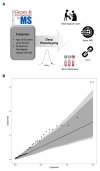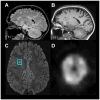Assessment of Early Evidence of Multiple Sclerosis in a Prospective Study of Asymptomatic High-Risk Family Members
- PMID: 28114441
- PMCID: PMC5348267
- DOI: 10.1001/jamaneurol.2016.5056
Assessment of Early Evidence of Multiple Sclerosis in a Prospective Study of Asymptomatic High-Risk Family Members
Abstract
Importance: Subclinical inflammatory demyelination and neurodegeneration often precede symptom onset in multiple sclerosis (MS).
Objective: To investigate the prevalence of brain magnetic resonance imaging (MRI) and subclinical abnormalities among asymptomatic individuals at risk for MS.
Design, setting, and participants: The Genes and Environment in Multiple Sclerosis (GEMS) project is a prospective cohort study of first-degree relatives of people with MS. Each participant's risk for MS was assessed using a weighted score (Genetic and Environmental Risk Score for Multiple Sclerosis Susceptibility [GERSMS]) comprising an individual's genetic burden and environmental exposures. The study dates were August 2012 to July 2015.
Main outcomes and measures: Participants in the top and bottom 10% of the risk distribution underwent standard and quantitative neurological examination, including disability status, visual, cognitive, motor, and sensory testing, as well as qualitative and quantitative neuroimaging with 3-T brain MRI and optical coherence tomography.
Results: This study included 100 participants at risk for MS, with 41 at higher risk (40 women [98%]) and 59 at lower risk (25 women [42%]), at a mean (SD) age of 35.1 (8.7) years. Given the unequal sex distribution between the 2 groups, the analyses were restricted to women (n = 65). When considering all measured outcomes, higher-risk women differed from lower-risk women (P = .01 by omnibus test). Detailed testing with a vibration sensitivity testing device in a subgroup of 47 women showed that higher-risk women exhibited significantly poorer vibration perception in the distal lower extremities (P = .008, adjusting for age, height, and testing date). Furthermore, 5 of 65 women (8%) (4 at higher risk and 1 at lower risk) met the primary neuroimaging outcome of having T2-weighted hyperintense brain lesions consistent with the 2010 McDonald MRI criteria for dissemination in space. A subset of participants harbor many different neuroimaging features associated with MS, including perivenous T2-weighted hyperintense lesions and focal leptomeningeal enhancement, consistent with the hypothesis that these individuals are at higher risk of developing clinical symptoms of MS than the general population.
Conclusions and relevance: Higher-risk asymptomatic family members of patients with MS are more likely to have early subclinical manifestations of MS. These findings underscore the importance of early detection in high-risk individuals.
Trial registration: clinicaltrials.gov Identifier: NCT01353547.
Conflict of interest statement
Figures



Comment in
-
Multiple Sclerosis-A Tuning Fork Still Required.JAMA Neurol. 2017 Mar 1;74(3):264-265. doi: 10.1001/jamaneurol.2016.5126. JAMA Neurol. 2017. PMID: 28114595 No abstract available.
References
Publication types
MeSH terms
Associated data
Grants and funding
LinkOut - more resources
Full Text Sources
Other Literature Sources
Medical
Miscellaneous

